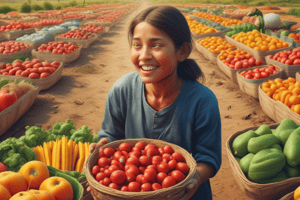Podcast
Questions and Answers
What is chronic hunger primarily caused by?
What is chronic hunger primarily caused by?
- Acute malnutrition due to sudden illness
- Temporary fluctuations in food availability
- Inadequate dietary diversity
- Long-term lack of food over an extended timescale (correct)
Which of the following components are part of food security?
Which of the following components are part of food security?
- Ready availability of nutritionally adequate foods (correct)
- A diet lacking in proper nutrition
- Lack of agricultural infrastructure
- Access to emergency food supplies only
What does the Global Hunger Index (GHI) use to rank countries?
What does the Global Hunger Index (GHI) use to rank countries?
- Only the percentage of undernourished population
- Four key indicators, including undernourishment and child wasting (correct)
- Underemployment rates and political stability
- Household expenditure on food
Which aspect is NOT measured in the Global Food Security Index?
Which aspect is NOT measured in the Global Food Security Index?
What does HALE stand for?
What does HALE stand for?
Which of the following best describes an epidemic?
Which of the following best describes an epidemic?
What is a common misconception about food security?
What is a common misconception about food security?
Which indicator is NOT part of the Global Hunger Index?
Which indicator is NOT part of the Global Hunger Index?
What is the primary indicator of child stunting?
What is the primary indicator of child stunting?
Which region had the highest levels of hunger in 2015?
Which region had the highest levels of hunger in 2015?
What is the average daily calorie intake recommended for a person?
What is the average daily calorie intake recommended for a person?
Which of the following conditions is an example of energy deficiency?
Which of the following conditions is an example of energy deficiency?
How does the nutrition transition differ between low-income and high-income countries?
How does the nutrition transition differ between low-income and high-income countries?
Which factor significantly influences Health-Adjusted Life Expectancy (HALE)?
Which factor significantly influences Health-Adjusted Life Expectancy (HALE)?
According to data from 2001, how much did the lowest income group in Canada lose in HALE compared to the highest income group?
According to data from 2001, how much did the lowest income group in Canada lose in HALE compared to the highest income group?
What is the primary consequence of chronic diseases related to HALE?
What is the primary consequence of chronic diseases related to HALE?
Flashcards
Chronic hunger
Chronic hunger
Long-term hunger due to persistent food shortages.
Food Security
Food Security
Consistent access to safe, sufficient, and nutritious food to sustain a healthy lifestyle for everyone
Epidemiology
Epidemiology
The study of diseases within populations.
Food security Index
Food security Index
Signup and view all the flashcards
Malnutrition
Malnutrition
Signup and view all the flashcards
Undernourishment
Undernourishment
Signup and view all the flashcards
Global Hunger Index
Global Hunger Index
Signup and view all the flashcards
Child Wasting
Child Wasting
Signup and view all the flashcards
Child Stunting
Child Stunting
Signup and view all the flashcards
Child Mortality
Child Mortality
Signup and view all the flashcards
Malnutrition Indicators
Malnutrition Indicators
Signup and view all the flashcards
Stunting
Stunting
Signup and view all the flashcards
Wasting
Wasting
Signup and view all the flashcards
HALE
HALE
Signup and view all the flashcards
Calorie Intake
Calorie Intake
Signup and view all the flashcards
Socioeconomic Status
Socioeconomic Status
Signup and view all the flashcards
Study Notes
Global Food Security
- Food security: All people have consistent access to sufficient, safe, and nutritious food. Includes ready availability, assured access (not resorting to risky methods), and sufficient nutrition for healthy lives.
- Global Food Security Index: Measures food security in 113 countries using 28 indicators for affordability, availability, and quality.
- 2015 Trends: Global food security improved, except in Europe where it declined.
- Components of Food Security: affordability, availability, and quality
- Affordability: factors like food costs, poverty rates, agricultural support, and farmer financing.
- Availability: supply sufficiency, agricultural research, infrastructure, and political stability.
- Quality and Safety (nutrition and food safety) : food diversity, micronutrients, protein quality, and food safety.
Global Hunger Index (GHI)
- Ranks countries by hunger severity on a 0-100 scale.
- Categories (low, moderate, serious, alarming, and extremely alarming).
- Four key indicators:
- Undernourishment: proportion of undernourished people.
- Child wasting: low weight for height in young children.
- Child stunting: low height for age in young children.
- Child mortality: under-5 mortality rate.
- 2015 Trends: Highest hunger in sub-Saharan Africa and South Asia.
- Progress seen in some countries (Rwanda, Angola, and Ethiopia).
Calorie Intake
- Global average: ~2,780 kcal/person/day.
- Minimum recommended intake: ~1,800 kcal/person/day.
- High-income countries: Up to 3,800 kcal/day.
- Low-income regions: ~1,820 kcal/person/day; lowest intake in Burundi and Eritrea (~1,600 kcal/person/day).
Malnutrition Indicators
- Deficiency diseases: result from lacking specific vitamins/minerals (e.g., pellagra).
- Protein deficiency: example Kwashiorkor.
- Energy deficiency: example Marasmus.
- Obesity: excessive intake.
- Starvation and famine: prolonged food unavailability.
- Stunted growth vs wasting:
- Stunting: long-term malnutrition (low height for age).
- Wasting: acute malnutrition (low weight for height).
- High rates in South Sudan, Eritrea, and South Asia.
- Low rates in Middle East, Latin America, and parts of Europe.
Nutrition Transition
- Low-income countries: mainly carbohydrates.
- High-income countries: diverse diets, including fats, meat, and dairy.
- Global trend towards protein-rich diets with rising incomes.
Health-Adjusted Life Expectancy (HALE)
- Measures healthy years lived.
- Combines life expectancy with adjustments for ill-health.
- Findings:
- Higher ill health burden for women than men.
- Greatest problems in early old age.
- Strong socioeconomic influence.
- Canada Specifics:
- Lower socioeconomic groups had much lower HALE in 2001 compared to higher socioeconomic groups (women by 3.2 years, men by 4.7 years).
- Chronic diseases (diabetes, hypertension) significantly reduced HALE.
- Diabetes reduced HALE by 5.8 years for women and 5.3 years for men. High blood pressure reduced HALE by 2 years.
Studying That Suits You
Use AI to generate personalized quizzes and flashcards to suit your learning preferences.




